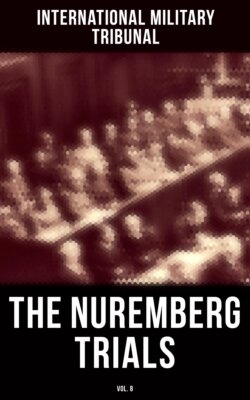Читать книгу The Nuremberg Trials (Vol.8) - International Military Tribunal - Страница 14
Afternoon Session
ОглавлениеMR. COUNSELLOR RAGINSKY: The looting and destruction of historical and artistic palaces in the town of Pushkin (Tzarskoe-Selo) was carried out with malice aforesight by order of the highest German authorities.
I omit the end of Page 47 and the beginning of Page 48:
“A considerable part of the Catherine Palace was burned down by the Germans. The famous ceremonial halls, 300 meters long and designed by Rastrelli, perished in the flames. The famous antechambers”—waiting rooms—“decorated by Rastrelli were likewise ruined.”
I omit one paragraph and continue:
“The Great Hall—outstanding creation of the genius of Rastrelli—presented a terrible spectacle. The unique ceilings, work of Torelli, Giordano, Brullov, and other famous Italian and Russian masters, were destroyed.”
I omit another paragraph.
“Equally ruined and pillaged was the Palace Church, one of Rastrelli’s masterpieces, famous for the exquisite workmanship of the interior decoration.”
I omit one more paragraph.
“In January 1944 the retreating German invaders prepared the complete destruction of all that was left of the Catherine Palace and adjoining buildings. For this purpose, on the ground floor of the remaining part of the palace, as well as under the Cameron Gallery, 11 large delayed-action aerial bombs were laid, weighing from 1 to 3 tons.
“In Pushkin the Hitlerite bandits destroyed the Alexander Palace, constructed at the end of the 18th century by the famous architect Giacomo Quarenghi.”
I omit a paragraph.
“All the museum furniture, stored in the basements of the Catherine and Alexander Palaces, items of artistic porcelain, and books from the palace libraries were sent to Germany.
“The famous painted ceiling, ‘Feast of the Gods on Olympus,’ in the main hall of the Hermitage pavilion was removed and shipped to Germany.”
I omit two paragraphs:
“Great destructions were caused by the Hitlerites in the magnificent Pushkin parks, where thousands of age-old trees were cut down.
“Ribbentrop’s special purpose battalion and the Kommandos Staff Rosenberg shipped to Germany from the Pavlovsky Palace extremely valuable palace furniture, designed by Veronikhin and by the greatest masters of the 18th century.”
I omit the end of Page 49 and the beginning of Page 50 of the report.
“During their retreat the fascist invaders set fire to the Paul’s Palace. The greater part of the palace building was entirely burned down.”
I omit the next two paragraphs and quote the last paragraph, which concludes this document:
“The Extraordinary State Commission established that the destruction of art monuments in Petrodvoretz, Pushkin, and Pavlovsk was carried out by the officers and soldiers of the German Army on the direct instructions of the German Government and the High Command.”
Many large towns were destroyed by the German fascist invaders in the occupied U.S.S.R. territories. But they destroyed with particular ruthlessness the ancient Russian cities containing monuments of ancient Russian art. I quote as an example the destruction of the cities of Novgorod, Pskov, and Smolensk. Novgorod and Pskov belong to these historical centers where the Russian people laid the foundation of their state; here, in the course of centuries flourished a highly developed and individual culture. It left a rich heritage which constitutes a valuable possession of our people. Thanks to the survival of numerous monuments of ecclesiastic and civil architecture, murals, paintings, sculpture, and handicraft, Novgorod and Pskov were rightly considered the seat of Russian history.
The Hitlerite barbarians destroyed, in Novgorod, many valuable monuments of Russian and foreign art of the 11th and 12th centuries. They not only destroyed the monuments but they reduced the entire city to a heap of ruins.
By way of proof, I shall read into the record some excerpts from the document presented to the Tribunal as Document Number USSR-50. You will, Your Honors, find these excerpts on Pages 333 and 334 of the document book. I read:
